| The Ji-Tong line stretches for over 800 kilometres from Jining to Tongliao. This remarkable provincial railway was not opened until December 1995 and for much of its length it travels over almost totally flat land. However near the village of Reshui the line begins to climb up into the mountains towards the town of Jingpeng. The first European to report on the existance of this line was a French enthusiast by the name of Julian Blanc, who travelled over the line by train. It was not long before the first lineside photographers were making their way to Inner Mongolia to marvel at this feat of modern engineering. What made this line particualry remarkable was that the provincial authorities had seen fit to buy a fleet of surplus QJ class 2-10-2 steam locomotives from China Rail to provide the motive power for the route. Given the amount of traffic using the route it was usual to use a pair of QJ's between Daban and Haoluku in order to provide sufficient power to haul long freight trains up and over the summit. The line is single track with frequent passing loops. and once beyond Galadesitai (Km 517) the locomotives climbed through the mountains by means of a series of horseshoe curves, massive embankments and two tunnels before reaching the summit of the line inside the tunnel near Shangdian (Km 494). Trains approaching from the east would pause at Jingpeng (Km 468) to build up steam before ascending the pass by means of several spectacular viaducts and four futher tunnels to reach the passing loops at Shangdian station. The combination of winter snows, extreme temperatures (as low as -40 degrees centigrade) and clear blue skies made a visit to Jingpeng an unforgetable experience and the line became a place of pilgrimage for photographers and railway enthusiasts from Europe, the USA and Japan. It was truly the 'Everest Of Railway Photography' and once experienced everything else somehow became something of an anti-climax. Sadly it wasn't destined to last. By 2004 the first diesels were beginning to make an appearance on the line and the last revenue earning QJ's made their final journey between Daban and Haoluku on 27th March 2005. Steam remained between Daban and Chabuga for another nine months until 9th December 2005. Whilst the line itself remains and has been continuously upgraded ever since, the sound of QJ's hard at work can no longer be heard. This page then stands as a tribute to the world's last mainline steam railway. |
| JINGPENG - THE EVEREST OF RAILWAY PHOTOGRAPHY |
| New Year's Day 1999 and desperately hung-over from the previous night's celebrations on board the overnight sleeper from Benhong, I climbed the hills behind Reshui and was rewarded for my efforts by the sight of QJ's 7012 and 6828 on a westbound train between Tunnels 6 and 7. Our guide also climbed the hill to bring fresh supplies of beer - which by the time he reached us had frozen solid in the bottles. 1 January 1999 |
| Just to the west of Reshui the line crosses a small stream and then the road which leads from Reshui to the summit. With QJ 7037 leading 7041, the two engines are beginning to dig in for the long climb towards the summit. Since the distance covered by the train is much further than that of the road, it was easy to reach the summit long before the train and to get a second photograph (see above) 1st January 1999 |
| In addition to the numerous freight trains that used the JiTong line there was also a passenger service. Unfortunately this crossed the Jing Peng section of the line in the hours of darkness and so photographs of passenger trains on the Pass are rare. However it did provide an excellent way of reaching Galadesitai and thence to Reshui and its hotels. On New Year's Eve 1998, 2-10-2 QJ No.7118 stands at the head of its train in Benhong station which is 35km from Jining - the western end of the line. |
 |
| Most photographers concentrated their attentions on the line to the east of Jingpeng station as this marked the start of the climb to the summit at Shandiang but approaching Jingpeng was a large viaduct over a river. Unfortunately it was a favourite place for locomotives to blow-down before arriving in the station and although QJ6656 can be clearly seen, QJ6517 and the train are lost in a large cloud of steam 3rd January 2002 |
 |
| Engines normally paused for some considerable time at Jingpeng station, taking water and building up their fires ready for the long climb. From this vantage point above Biligou Viaduct it was possible to watch the trains leave the station and enjoy the sight of them progressing along the side of the valley before crossing the concrete viaduct. The climb to reach this spot was arduous but the reward of seeing QJ's 6536 and 7040 hard at work made it all worthwhile 2 January 2002 |
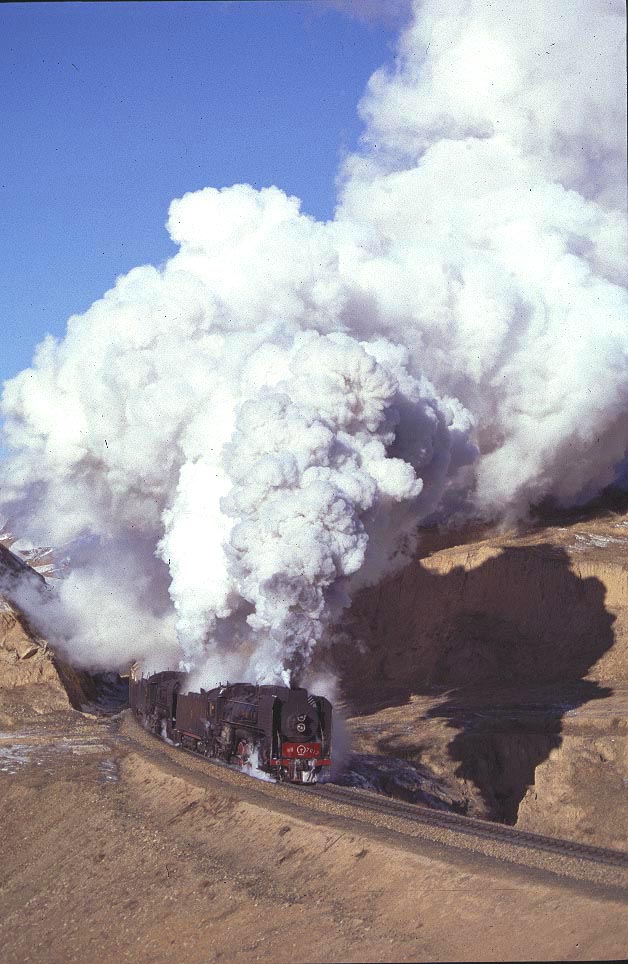 |
| "When a man is tired of Jingpeng, he is tired of life; for there is at Jingpeng all that steam can afford" (with apologies to Samuel Johnson) Surely there was never anywhwhere else in the world that could provide a spectacle such as this. The combination of intense cold and the need to haul their long trains off the viaduct and up the 1 in 80 gradient led to spectacular steam and smoke effects just to the east of Jingpeng. QJ7012 and an unidentified second engine cross the embankment and through the quarry at Biligou 3 January 1999 |
| Si Ying Mi Viaduct is commonly referred to as the Horseshoe Viaduct and is perhaps the iconic symbol of the line. This immense curved viaduct is part of a gigantic construction which carries the line through a full 360 degree turn as it climbs ever onwards towards the summit. The early morning light brings out all the colours in the exhaust as QJ's 6577 and 6828 thrash their way across the viaduct with an eastbound train on 2nd January 2002 |
 |
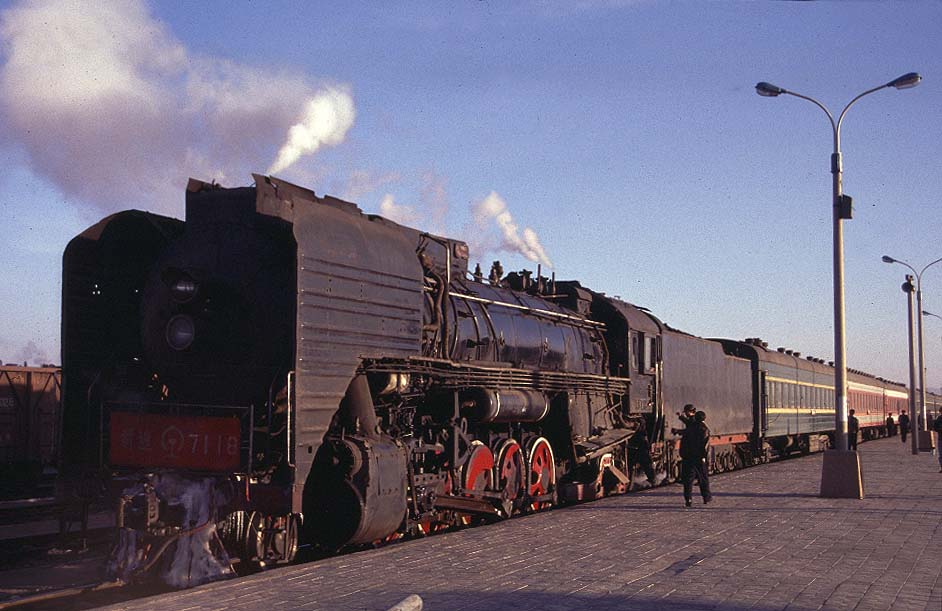 |
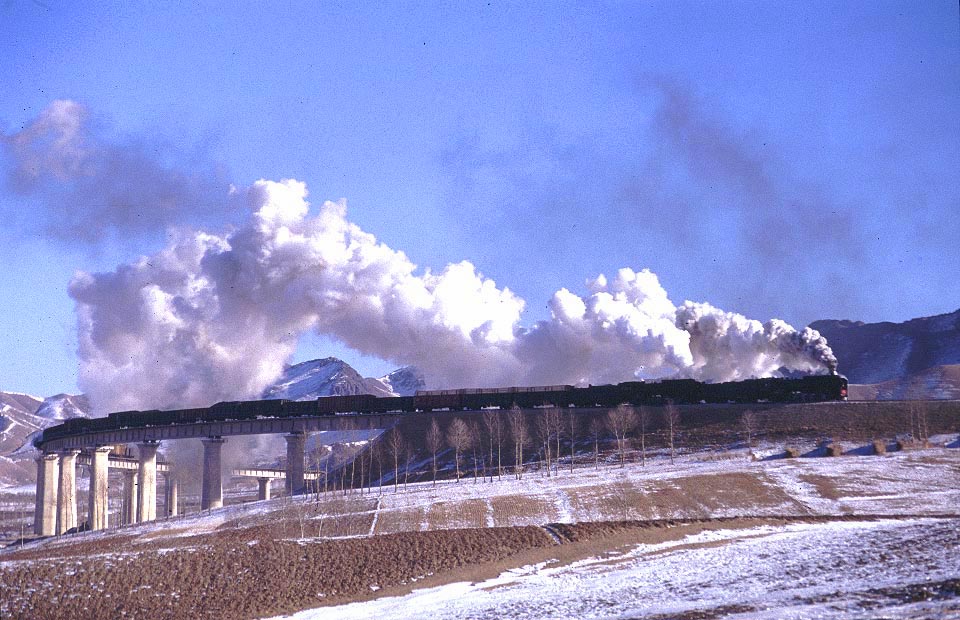 |
| Later in the day - further round the viaduct and slightly further up the hill to catch another pair of eastbound QJ's flogging their way uphill to Shangdian and the summit of the line. One thing was certain - to catch the best of the action you had to be fit and also prepared to walk considerable distances. |
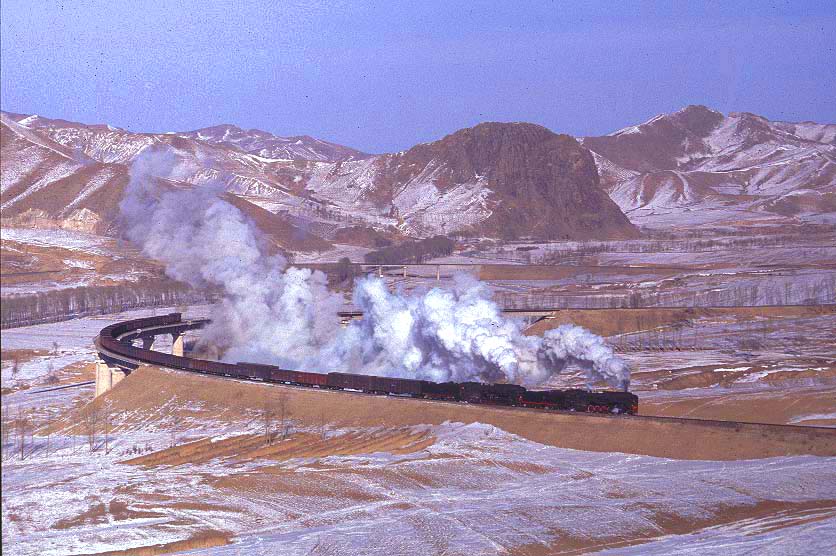 |
| However the rewards for one's endeavours could certainly be spectacular. As always much depended on the mood of the gods - the weather could change rapidly and bring a day's photography to a premature end. The biting winds could also play havoc, whipping the smoke off the chimney top and blowing it down across the train. But ...... when it did all come together it was well worth all of the previous frustrations. |
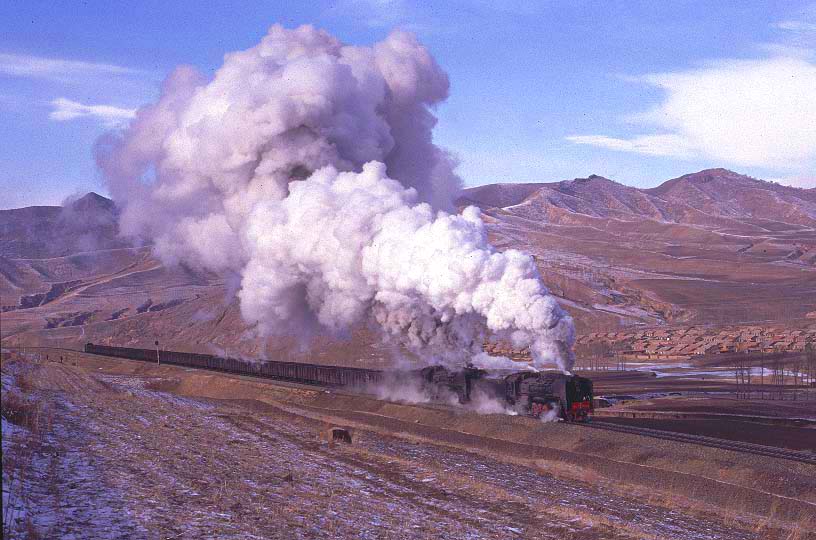 |
| At Km485 the line takes a sharp curve and heads south, climbing into what is known as Brickworks Valley. The gradient now is about 1 in 80 and the train has travelled some 20km since leaving Jingpeng and faces a further 10km of climbing to reach Shangdian. QJ6828 and 6577 are well in control of their train as they climb up into the valley on in January 2002 |
 |
| QJ's 6905 and 6763 hurry a long train of oil tanks westwards down the grade towards Jingpeng. The line is single track and has numerous passing loops along the way. This pair had been held at Shangdian awaiting the arrival of an eastbound train and are now heading for Jingpeng where they will almost certainly meet the next train waiting to climb up and over the pass. |
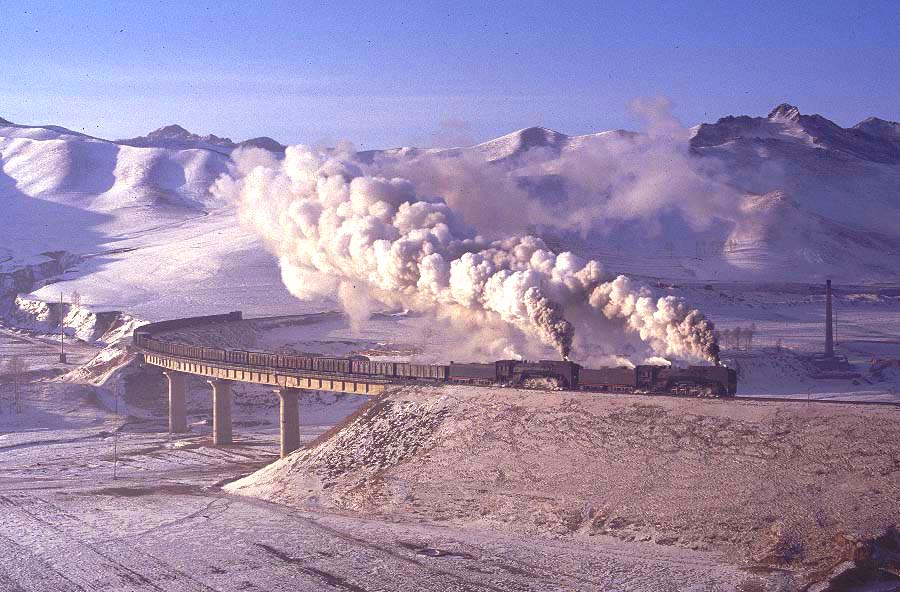 |
| In the middle of winter the daylight hours are relatively short and the sun late to rise in the sky. There was much debate as to whether it would be possible to get a shot at this location since it relies on early morning sun and a train arriving at more or less the right moment. Sometimes everything does come together perfectly and this was once such occasion. The two unidentified QJ's have just passed over the viaduct at the head of Brickworks Valley (the brickwork chimney can be seen in the background) and they are about to plunge into the first of three short tunnels on the final section of the climb. of 3rd January 1999 |
 |
| Definately a long climb and a fairly precarious perch was required to capture this shot of QJ6986 and an unknown sister locomotive between Tunnel 2 and 3. The western side of the line seems to have the most spectacular vantage points and in winter it frequently has a far deeper snowfall than on the eastern side of the summit. January 2002 |
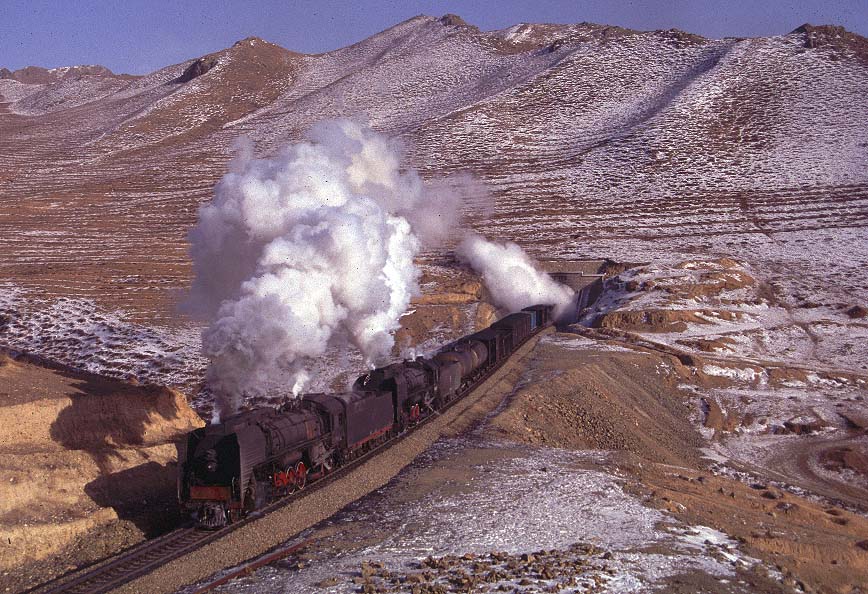 |
| It was a shot similar to this which first attracted me to the Jingpeng line. The circumstances were to say the least somewhat unusual. I was at Boris Luis Santa Columba sugar mill in Cuba in April 1998 and after a hard morning's photography I was relaxing at a local roadside rum stall with Ron Lingley and Andy Clarke To our amazement there was a large photograph pinned to the rear wall clearly placed there by a fellow enthusiast. By the time we had finished our drinks a plan had been hatched and eight months later we were on our way! |
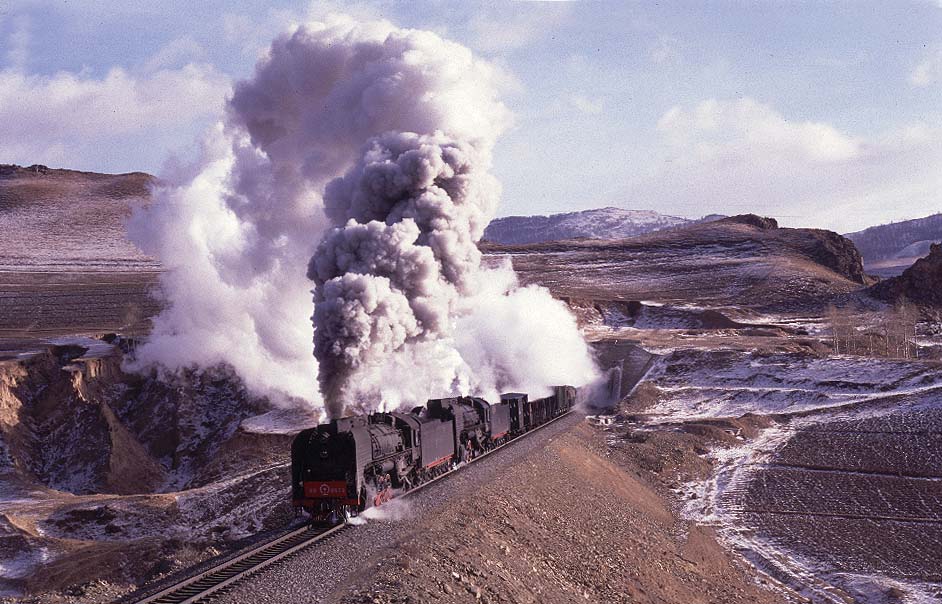 |
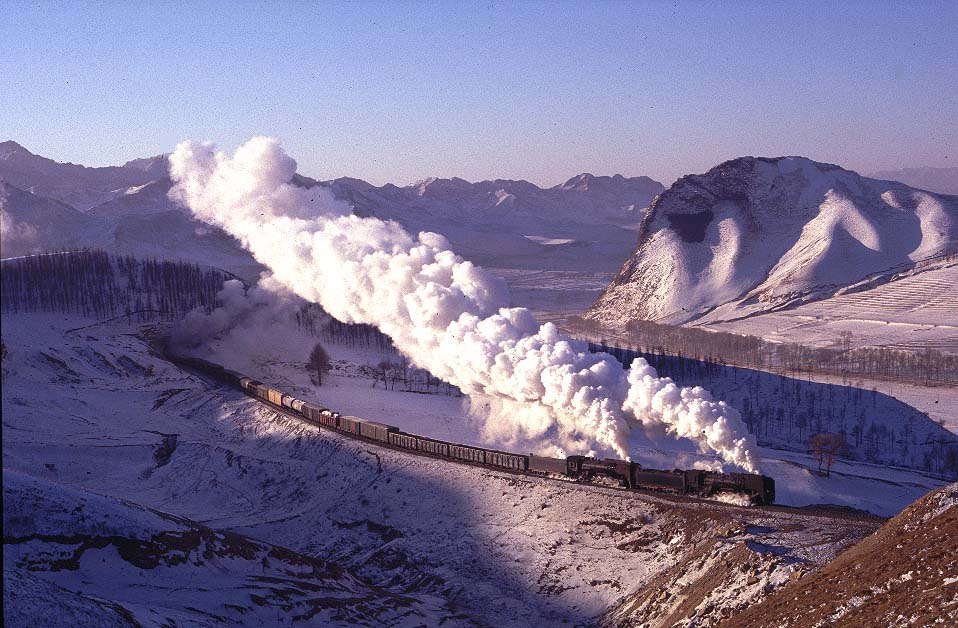 |
| One visit to Jingpeng was never going to be enough although our 1999 trip was blessed with excellent weather and we covered most of the well known locations. Somewhat concerned about the potential problems of the so-called 'Millenium Bug' the following season was given a miss as was 2000-2001 but in January 2002 it was time to make a return for a further six days on the lineside. Here QJ's 6986 and 6828 are exiting from Tunnel 3 with an eastbound train. |
| Another shot which was an act of faith! One of our 2001-2 party persuaded us to make the long climb to be above the exit to Tunnel 4. We set off in pre-dawn light and climbed ever higher above the road and then above the line. On arriving at our chosen vantage point it was clear that the sun would not be on the line for some considerable time. Eventually we heard the sounds of a train heading east and all we could do was watch and hope that the sun would climb high enough to reach the line. It was a close run thing but ultimately the result was sufficient justification for our enterprise. |
 |
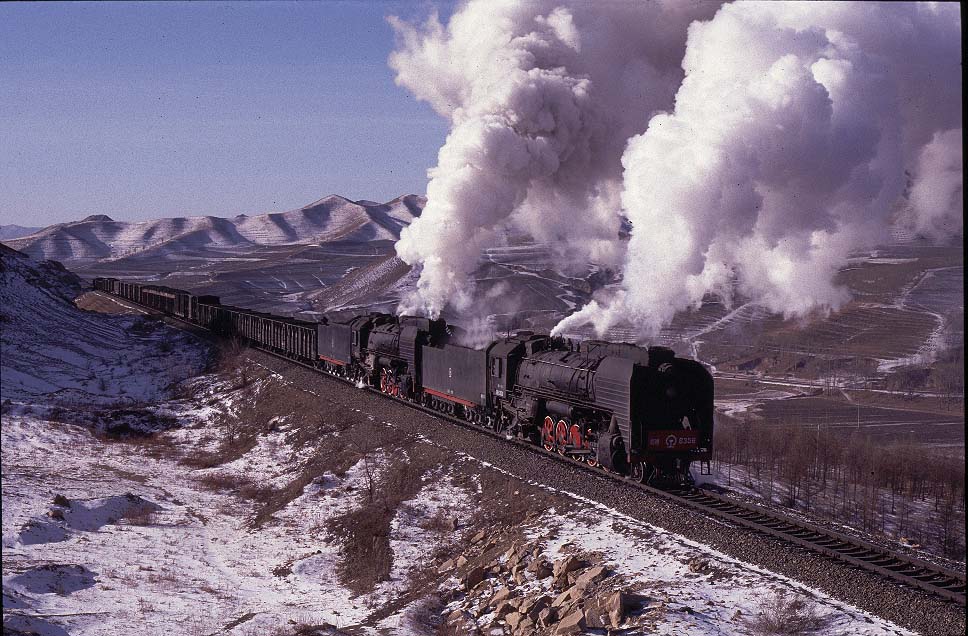 |
| The long climb from Jingpeng is nearly over for the crews of QJ 6274 and 6763 as they approach Km 491 and into sight of Shangdian and the summit of the line. At this point the line is about 1300 metres above sea level. |
| A similar shot taken two years earlier - slighly lower and slightly closer to Shangdian. On this occasion the locomotives are QJ 6656 and 6517. 2nd January 1999 |
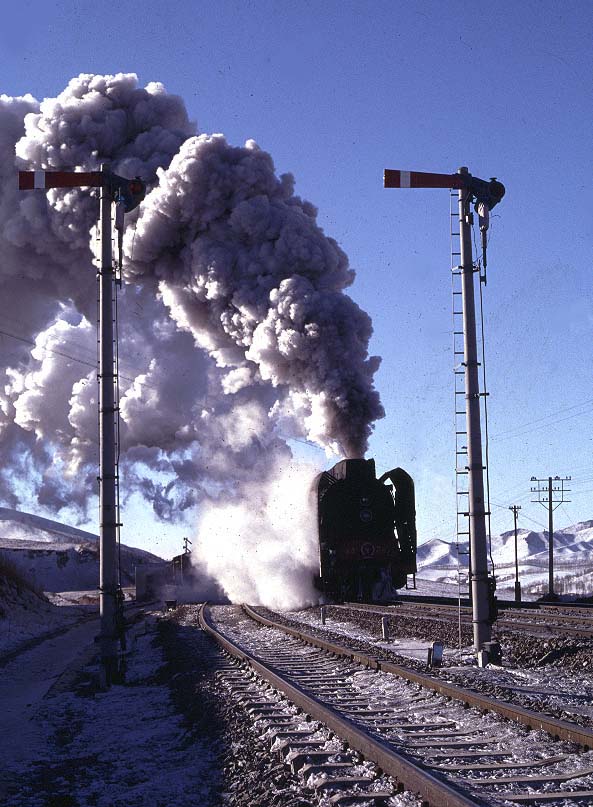 |
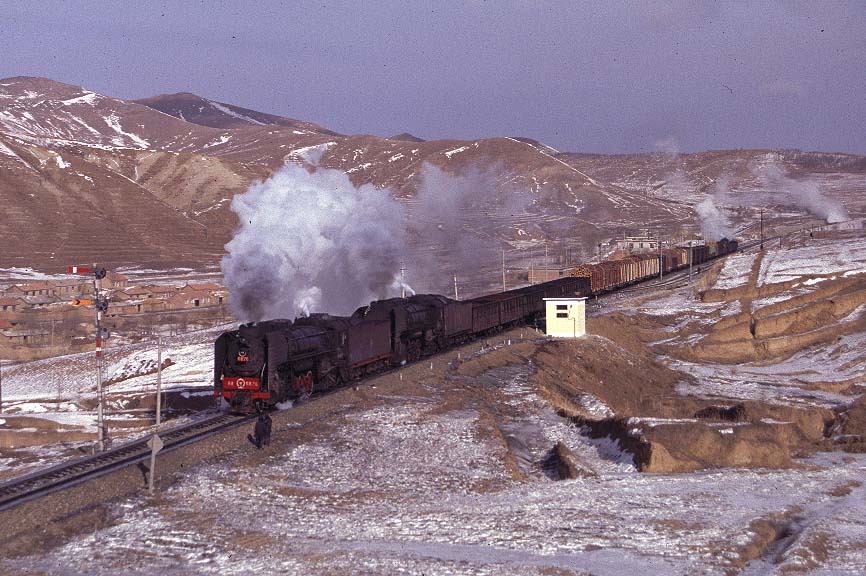 |
| Shangdian station is just a few hundred metres short of the summit which is actually inside the tunnel to the east of the station. Shangdian has four roads, two of which are loops and two of which are running roads. There are (were?) also a number of semaphore signals to control movements in the station area and these are Great Western Railway style lower-quadrant signals An westbound train has just left Shangdian and is beginning the long coast downhill to Jingpeng station (above) 1st January 1999 An unidentified QJ is framed between signal posts as it arrives at Shangdian with an eastbound freight train (right) 1st January 1999 |
 |
| With just a few hundred yards to go before they reach the summit the footplate crews of QJ 7040 and QJ 6760 can begin to look forward to a little rest and relaxation as they begin the 25km descent towards Reshui and relief at Daban summit |
 |
| Similar thoughts of rest and relaxation are probably in the minds of the crews of QJ7037 and QJ7041 as they approach the summit but with a westbound train from Haoluku and beyond. They can now look forward to the downhill run to Jingpeng. The road from Reshui crosses the line at this point providing an ideal photographic location for those less able or less inclined to access other vantage points. 2 January 1999 |
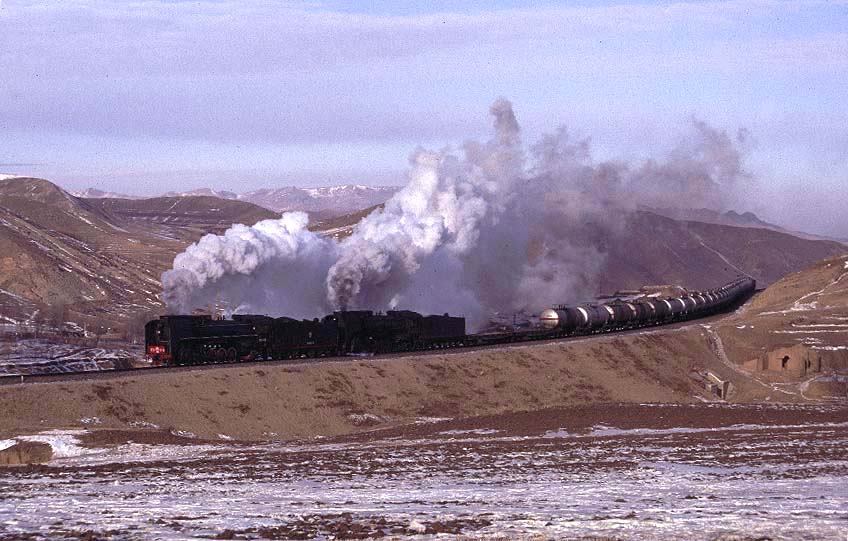 |
| A long train of tank wagons passes the village of Shi Di heading for the summit and then on to the west. This location was easily accessed by walking along the track from Summit Tunnel. |
 |
| This was actually the last picture that I took on the JiTong line. QJ6378 is single handed as it brings a long train of bogie bolster wagons past the semaphore signals guarding the entrance to Liu Di Gou station. The station itself simply served as a passing loop and whilst manned 24 hours a day never saw passengers. As everywhere else the station staff were welcoming and happy for me to warm my bones besides their fire. Despite the sunshine the temperature was about minus 15 degrees! 3 January 2002 |
 |
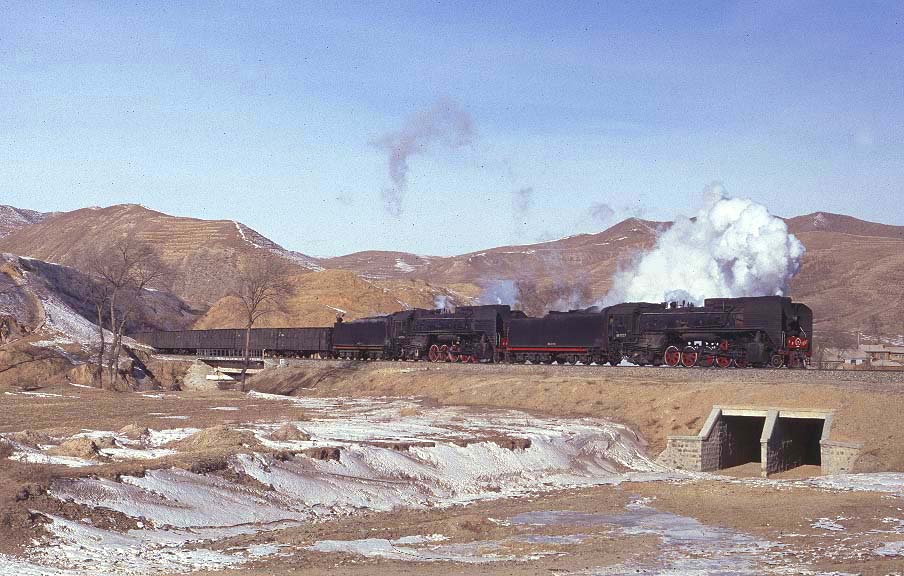 |
 |
| The difference in snow cover resulting from the lower altitude and being on the east side of the Pass is very noticeable as QJ7137 crosses a small bridge between Galadesitai and Reshui on the evening of 2nd January 1999. This turned into an epic stuggle in the fading light as the single engine struggled towards the summit at Shangdian. It was a great tribute to the skills of the crew that it made it without failing or slipping to a standstill. |
 |
| During the 2001-2 trip we made the 85km trip by road to visit Daban depot. At that time it was the largest steam depot in the world and we found over 20 QJ's on the shed - some in steam, some under repair and some in store. Chinese railways don't have engine sheds in the same was as in Britain, with most locomotives remaining outside at all times. Access to the depot was achieved without problem - the Chinese having already decided that 200 yuan was a good price to extract from steam-mad foreigners! |
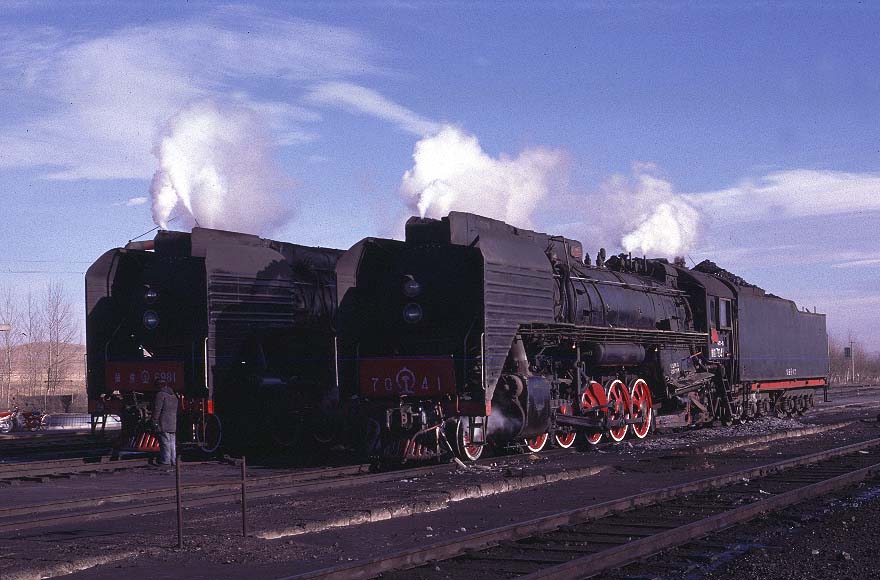 |
| The sheer size and scale of these QJ's (Qian Jin - 'Advance') can be best appreciated by comparing them to the figure standing in front of the bufferbeam of QJ6981. The overall length of engine and tender exceeds 90 feet and it has an operational weight of 250 tons. QJ7041 and 6981 at stand in the depot yard at Daban 4/01/2002 |
 |
| Having travelled from Benhong to Galadesitai in 1999 we decided to reach Jingpeng in 2002 from the eastern end and caught the train from Tongliao. This provided us with an opportunity to visit the depot at Zhelimu and to see locomotives such as QJ7163 arriving and departing the depot. Locomotives did not work the full length of the line and were changed at Chabuga and again at Daban during our 320km overnight journey. |
 |
| Facilities at Zhelimu were far more basic than those at Daban depot. All maintenance, preparation and disposal work was carried out in freezing conditions and a brisk wind kicked up clouds of ash and coal dust. In this photograph the depot's steam crane is collecting ash from the disposal pits as two QJ's take water. |
| Click on locations below for more Chinese steam (systems shown in yellow no longer have steam) ANSHAN STEELWORKS BAOTOU BEITAI STEELWORKS BENXI STEELWORKS CHENGDE HANDAN STEELWORKS FUXIN NANPIAO MEIHEKOU JIXI TIEFA WEIHE XUANHAU STEELWORKS YUANBAOSHAN |